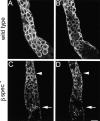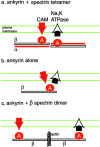Drosophila beta spectrin functions independently of alpha spectrin to polarize the Na,K ATPase in epithelial cells
- PMID: 10791978
- PMCID: PMC2174857
- DOI: 10.1083/jcb.149.3.647
Drosophila beta spectrin functions independently of alpha spectrin to polarize the Na,K ATPase in epithelial cells
Abstract
Spectrin has been proposed to function as a sorting machine that concentrates interacting proteins such as the Na,K ATPase within specialized plasma membrane domains of polarized cells. However, little direct evidence to support this model has been obtained. Here we used a genetic approach to directly test the requirement for the beta subunit of the alphabeta spectrin molecule in morphogenesis and function of epithelial cells in Drosophila. beta Spectrin mutations were lethal during late embryonic/early larval development and they produced subtle defects in midgut morphology and stomach acid secretion. The polarized distributions of alphabeta(H) spectrin and ankyrin were not significantly altered in beta spectrin mutants, indicating that the two isoforms of Drosophila spectrin assemble independently of one another, and that ankyrin is upstream of alphabeta spectrin in the spectrin assembly pathway. In contrast, beta spectrin mutations had a striking effect on the basolateral accumulation of the Na,K ATPase. The results establish a role for beta spectrin in determining the subcellular distribution of the Na, K ATPase and, unexpectedly, this role is independent of alpha spectrin.
Figures









Similar articles
-
Spectrin functions upstream of ankyrin in a spectrin cytoskeleton assembly pathway.J Cell Biol. 2006 Oct 23;175(2):325-35. doi: 10.1083/jcb.200602095. J Cell Biol. 2006. PMID: 17060500 Free PMC article.
-
Segregation of two spectrin isoforms: polarized membrane-binding sites direct polarized membrane skeleton assembly.Mol Biol Cell. 1997 Oct;8(10):1933-42. doi: 10.1091/mbc.8.10.1933. Mol Biol Cell. 1997. PMID: 9348534 Free PMC article.
-
Association of kidney and parotid Na+, K(+)-ATPase microsomes with actin and analogs of spectrin and ankyrin.Eur J Cell Biol. 1990 Oct;53(1):93-100. Eur J Cell Biol. 1990. PMID: 1963843
-
An Adaptable Spectrin/Ankyrin-Based Mechanism for Long-Range Organization of Plasma Membranes in Vertebrate Tissues.Curr Top Membr. 2016;77:143-84. doi: 10.1016/bs.ctm.2015.10.001. Epub 2015 Nov 30. Curr Top Membr. 2016. PMID: 26781832 Review.
-
Role of the membrane-cytoskeleton in the spatial organization of the Na,K-ATPase in polarized epithelial cells.Soc Gen Physiol Ser. 1991;46:77-87. Soc Gen Physiol Ser. 1991. PMID: 1653995 Review.
Cited by
-
A mutant plasma membrane ATPase, Pma1-10, is defective in stability at the yeast cell surface.Proc Natl Acad Sci U S A. 2001 Jul 31;98(16):9104-9. doi: 10.1073/pnas.161282998. Proc Natl Acad Sci U S A. 2001. PMID: 11481477 Free PMC article.
-
Adaptation of core mechanisms to generate cell polarity.Nature. 2003 Apr 17;422(6933):766-74. doi: 10.1038/nature01602. Nature. 2003. PMID: 12700771 Free PMC article. Review.
-
Transgene rescue identifies an essential function for Drosophila beta spectrin in the nervous system and a selective requirement for ankyrin-2-binding activity.Mol Biol Cell. 2010 Aug 15;21(16):2860-8. doi: 10.1091/mbc.E10-03-0180. Epub 2010 Jun 23. Mol Biol Cell. 2010. PMID: 20573981 Free PMC article.
-
Spectrin mutations that cause spinocerebellar ataxia type 5 impair axonal transport and induce neurodegeneration in Drosophila.J Cell Biol. 2010 Apr 5;189(1):143-58. doi: 10.1083/jcb.200905158. J Cell Biol. 2010. PMID: 20368622 Free PMC article.
-
The Drosophila Anion Exchanger (DAE) lacks a detectable interaction with the spectrin cytoskeleton.J Negat Results Biomed. 2010 Jun 23;9:5. doi: 10.1186/1477-5751-9-5. J Negat Results Biomed. 2010. PMID: 20573195 Free PMC article.
References
-
- Baumann O., Lautenschlager B., Takeyasu K. Immunolocalization of Na,K-ATPase in blowfly photoreceptor cells. Cell Tissue Res. 1994;275:225–234. - PubMed
-
- Bennett V., Gilligan D.M. The spectrin-based membrane skeleton and micron-scale organization of the plasma membrane. Annu. Rev. Cell Biol. 1993;9:27–66. - PubMed
Publication types
MeSH terms
Substances
Grants and funding
LinkOut - more resources
Full Text Sources
Molecular Biology Databases

